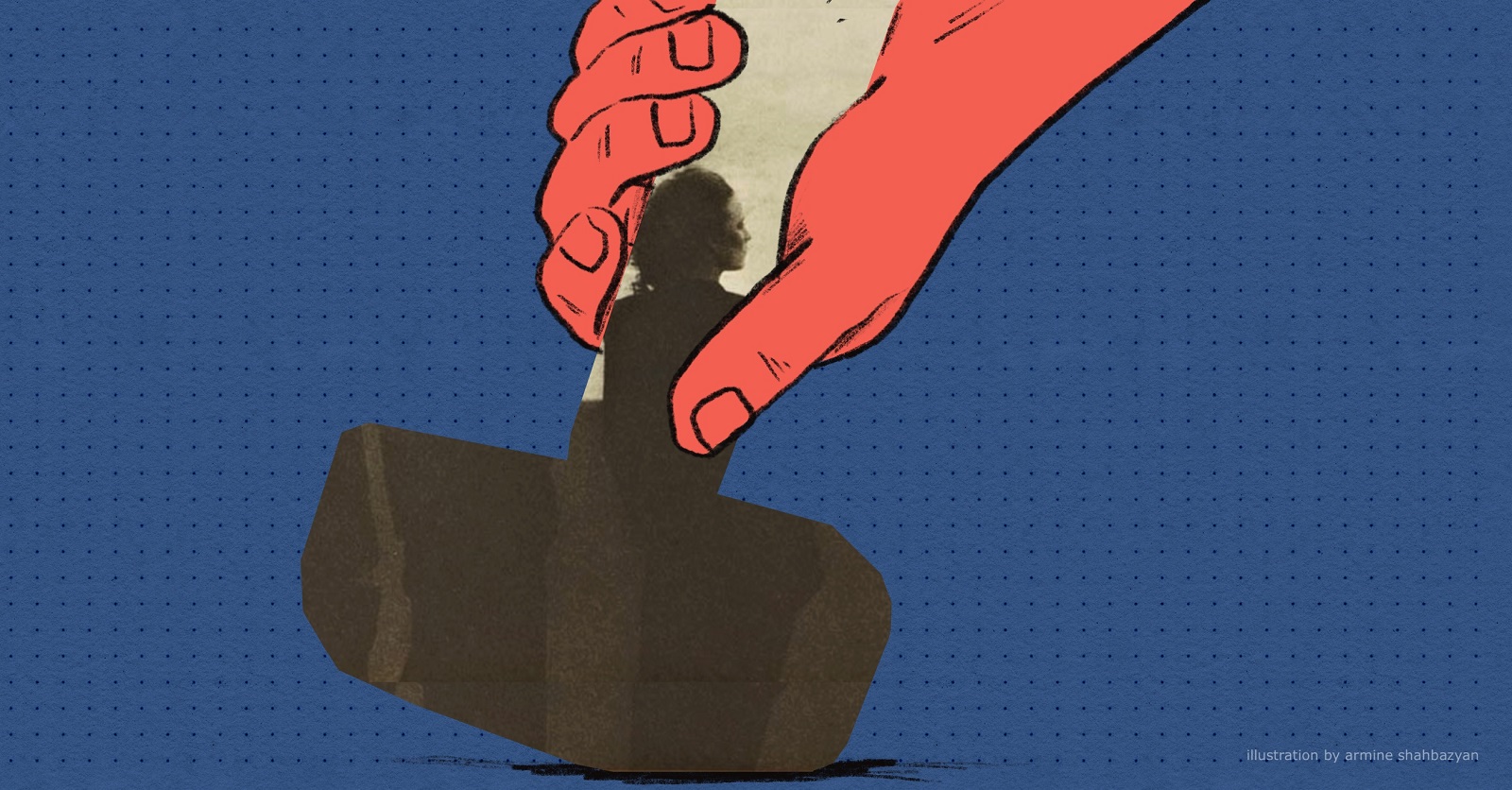
Visiting one post-Soviet state, you can then recognize it in all others – the similar patterns of urban planning and the identical buildings, structures, roads, pipes, wires, tiles, etc. However, an outsider delving inside under the extreme familiarity of the material environment finds an extreme “strangeness” of social interactions and practices. The “Outside In” series is about emplaced paradoxes and nuances. It spotlights the mundane in Armenia’s peripheral locations, where the seemingly unspectacular encounters with people and things allowing us to capture the unique features of the territory.
Going forward, all English language articles on EVN Report will have audio versions.
Listen to the article.
Outside In
Essay 5
Upon reviewing the stories that comprise the Outside In series, it becomes evident that when I write about people, it is actually women about whom I write. One might claim that this aligns with current developments in identity politics and knowledge production, suggesting that I’m attempting to be “authentic” by focusing on the “historically oppressed” gender. However, it was never my explicit intention to engage with the female experience or to essentialize identities. My focus on women has always been my spontaneous tactic in conducting research in Armenia. It is a typical utilization of what anthropologist James Scott famously described as “weapons of the weak” –– a subtle, informal, and often covert form of resistance in the face of uneven power relations.
Ethnography uniquely emphasizes personal relationships and the personality of the researcher in social science research. Factors like gender, class, race, ethnicity, and experience inherently shape the relationships in the field and the knowledge produced. The term “positionality” refers to the worldview of the researcher and their stance toward the research objective and its social and political context. Broadly, it defines and sets limits on the assumptions of the researcher, and the spaces they can access.
Several months after the start of the Russia-Ukraine war, I arrived in Armenia. As a Russian passport holder, I was ready to be shamed and bashed as a “Russian imperialist”. While ethnically, I am not Russian, but a Slavic muddle with a Jewish touch, no one seemed to care. In any case, my worries were about the wrong thing. It was not my nationality* that caused me problems, but my gender.
Living in a small Armenian town where it is still considered shameful, perhaps even outrageously promiscuous, for a woman to make eye contact with men in the street, let alone approach them with questions, I found it nearly impossible to have productive conversations with men. Of course, they didn’t shirk my presence –– they spoke gladly. But it was mostly never about what I was interested in, such as pipes, wires, boiler rooms, public spaces, and repair. Rather conversations with them shifted to revolve around topics and proposals, which I tried to avoid.
This is not an attempt to denigrate Armenian men specifically. It is a common struggle for female anthropologists around the world, especially those doing research in the so-called traditional (read: patriarchal) settings.
Encounter On the Square
On an unremarkable May day at my field site, I received the usual responses of “there is nothing” [բան չկա] and “no news” [նորություն չկա] to my greeting questions while swiftly crossing the empty square to grab a coffee at the café. The sun was gently shining and the wind rustled the greenery. It was a mundane yet delightful scene.
I sat on the bench, reading Martin Demant Frederiksen’s book “Anthropology of Nothing in Particular” savoring my slightly bitter hot drink in a dusty rose colored cup. As soon as I got comfortable, an old man who was playing backgammon in a gazebo by the square stood up leaving his mates and approached me.
The conversation started amicably, with him enquiring who I was. Although people claimed there was “no news,” my presence was indeed news in this small town piquing interest and enabling me to meet more people. But the innocent conversation soon took an unwelcome turn as the man began complimenting my face and body, inviting me to “drink wine, dance, and kiss.”
At first, I thought I had misheard. But he repeated the invitation. Not only was the nature of his blunt proposal astonishing, but also his confidence that I might even for a second consider agreeing. As polite as it was possible, I used various straightforward ways to say no. Yet, my refusal was just not a thing to be taken into consideration –– “a girl’s word is worthless” [աղջկա ասածը ասնավանի չի], as the saying goes.
Finally, infuriated, I resorted to using helpful male-repellent phrases in Armenian: “I am not a pair for you” [ես քո թայը չեմ] and “know your place” [տեղդ ճանաչիր]. Whether it was my use of Armenian suggesting potential protection from Armenian male relatives, or my very rude tone, but he backed off.
This was not the first instance of verbal harassment during my fieldwork, but it was the last drop. After discussing this with several of my more experienced Armenian female colleagues, who have navigated the gendered challenges of fieldwork in Armenia, it became clear that I was not going anywhere. It was time to stop knocking on a sealed door, trying to make the men in this small town see me as a professional. Concentrating solely on women was a difficult choice but the only logical solution.
Women as “Objects” in Imperial Politics
While I initially mentioned that my issue was not nationality, but gender, this is not entirely accurate. The problem was not nationality itself, but rather the combination of ethnicity and gender. In the Caucasus and Central Asia, there is a persistent stereotype about the “looseness” of Slavic women, contrasting them with the local modest and chaste women. I am not sure when this stereotype emerged exactly, but it came out of cultural clashes between ethnic groups within the Russian Empire and later, the Soviet Union. In this sense, it is a byproduct of Russian/Soviet imperialism, which, like its counterparts around the world, ruled by producing differentiation and exemptions, creating and maintaining hierarchies along ethnic and racial lines.
(Post)imperial ethnic differentiations play out very unequally for men and women. Men were always at the center of imperial experience, put simply –– “white” men as agents of empire, and “non-white” men as their subjects. Women, on the other hand, were the intermediaries, shaping imperial contact zones. They were objectified and used for pushing imperial agendas or subverting hierarchies. For instance, historian Adrienne Edgar notes that the Soviet state encouraged mixed marriages, seeing Slavic women as a means for “civilizing” the “backward” republics. However, most of these women acted contrary to the state’s intentions, choosing to fully embrace local traditions to prove their “worthiness” to their husbands and their families.
In his book “Voices from the Soviet Edge”, political scientist Jeff Sahadeo argued that male migrants from Central Asia and the Caucasus to Moscow and Saint-Petersburg used their ability to attract local women as evidence of belonging “in the heart of the Soviet Union.” The collapse of the USSR, with the increased labor migration from former Soviet republics to Russia, fixed three distinct roles. These roles perpetuate the reproduction of harmful stereotypes: the Russian mistress, the male migrant laborer, and the housewife back home. A “blond Russian seductress” versus the dark haired “docile (Armenian, Kazakh, Azeri, Tadjik, Uzbek, Kyrgyz, etc.) woman.”
When Patriarchy and Imperialism Collide
It is not news that the Caucasus region is ill-famous for gender violence, which EVN Report also wrote about a year ago. However, what remains obscured is the divergence of gender violence along ethnic lines. This issue is gaining increased relevance in Armenia due to the in-migration of Slavs since 2022. As an illustration of the divergence, which I hope to be forgiven for by gentle-souled readers, I will share a horrible and nasty, yet unfortunately quite telling joke “gifted” to me by an Armenian interlocutor whose name will forever remain classified:
An Armenian man working in Russia marries a Russian woman and brings her home to live with his parents. At some point he goes back to Russia for work. Upon his return, he finds the wife with a black eye. Naturally, he goes to inquire about the situation with his father:
Father, what happened? Why is she beaten up?
Well, I asked her to bring me coffee several times, but she never responded, so I tried to educate her.
Father, but she is Russian and does not understand your language.
Oh! She is Russian. Why didn’t you tell me that before? I could have f***** her.
The joke basically normalizes physical violence toward Armenian women and sexual violence toward Russian women, or more broadly, Slavic women. Serving as an encapsulation of numerous terrible lived experiences, it is an ethnographic artifact. However, the question remains: can it be subject to cultural relativism?
*In this text “nationality” pertains to citizenship, while “ethnicity” refers to the ethnic group.
See all [Outside In] articles here


